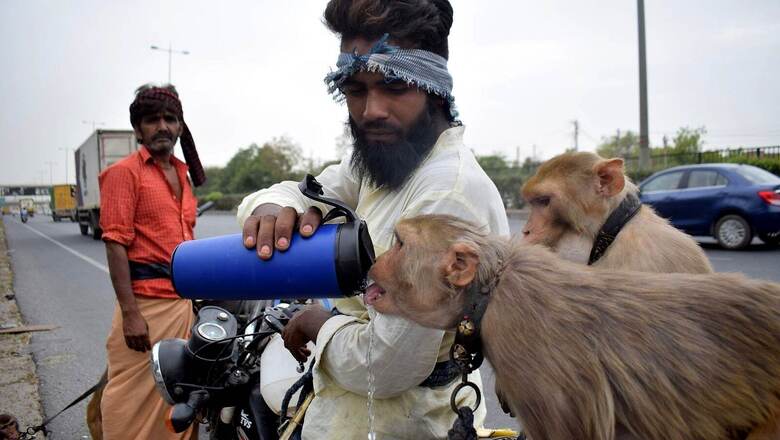Science-Wise: Climate Change is Fueling More Heatwaves But Our Lifestyle Choices Are Making It Worse

views
As temperature touches record high across major parts of the country, it has made life in cities more unbearable than it already was. The mercury surged past 44℃ consistently for days, driving up the use of air-conditioners, leading to peak power demand and more individual vehicles, compounding the problem all the more.
Scientists have long warned that such heat waves are likely to get more intense and more frequent in the coming years. Yet, these calamitous events capture our attention only when they are staring us in the face. On most other days, life goes on as it normally would, with our daily activities slowly aggravating the climate woes.
Personal Accountability
Science is clear that human influence has contributed to the global changes in frequency and intensity of daily temperature extremes since the mid-20th century. According to the Intergovernmental Panel on Climate Change (IPCC), it has more than doubled the probability of occurrence of heat waves in some locations.
Their human impact, however, remains most disconcerting. The vast socio-economic inequalities ensure that millions of people whose contribution to the problem remains marginal are more exposed to the brutality of this weather, while the other half are just habituated to turn on their individual air-conditioning systems that eventually ensure the air outside gets more heated than before.
According to the National Disaster Management Authority (NDMA), fatality due to heat waves has come down in the past few years due to rising awareness, but a majority of those who are still succumbing are daily-wage workers who toil in the sweltering heat, and sleep on the pavements.
The latest IPCC report pointed at this stark disparity: Globally, 10% of households with the highest per capita emissions contribute a disproportionately large share, roughly 34-45% of global consumption-based household emissions, while the bottom 50% contributes only 13-15%.
While bridging these socio-economic inequalities may take years, what we can certainly do now is minimise our contribution to the overall problem. The Working Group III of the IPCC made a commendable start to this in their latest report which discussed these individual measures in detail.
What’s your Carbon Footprint?
It all begins with a simple question — what is your carbon footprint? From switching on lights in the morning, to driving a car to your office, or disposing waste in the evening — all these activities cause greenhouse emissions and together make up your carbon footprint.
A choice to walk/cycle than taking a car, to adapting your house to more natural ways of cooling, reducing air travel, minimising/recycling waste, and reducing power usage are conscious choices that could turn things around in a significant way if done collectively.
According to IPCC, having the right policies, infrastructure and technology in place to enable changes to our lifestyle and behaviour can result in a 40-70% reduction in emissions by 2050. Policies that avoid the demand for energy and materials contribute 10% to this potential, energy efficiency policies contribute 42%, and renewable energy policies 9%.
Take Delhi for example: Whether it is the hell-like fire that breaks out in our landfills every year, or the suffocating pollution that chokes us every winter, or the impact of heat wave this summer, the roots of the problem may be linked to our everyday habits.
The air quality data from Indian Institute of Tropical Meteorology (IITM), Pune, suggests that vehicular traffic is contributing at least 40 per cent to the air pollution that the national capital struggles with every year. The hard-selling of cars make it worse, especially the diesel-guzzling SUVs.
As years pass, the travel practices of the teeming millions will determine the liveability of Delhi. We have done a shoddy job in encouraging those who prefer to use alternate ways for commuting — cycling for instance, or public transport that is yet to be adequately strengthened. Those who do, do out of personal will, and without the necessary infrastructure in place. Creating walkable areas in cities without a need for vehicle transport is needed, but most cities like Delhi remain devoid of that.
Our buildings — residential and office spaces — aren’t offering any respite either with inadequate natural cooling systems, and are heavily air-conditioned. The Urban Island Heat effect that is rendering our cities unliveable in summers can be tackled with sustainable urban planning and infrastructure design — the green roofs and facades, networks of parks and open spaces, and water-sensitive design.
Science has shown how well-designed new buildings and existing ones, if retrofitted, can help us in adapting to future climate. Recent studies which project that up to 61% of global building emissions could be mitigated by 2050 inspire some confidence.
Sustainability Is the Word
It is 2022, and we have come far away, rather quickly from days when sustainability, and minimalism was an option for few. It is time that we must embrace it, especially those who have the resources and the means to do so. This includes those who have access to modern energy services — access to clean, reliable and affordable energy services for cooking and heating, lighting, communications, and productive uses.
Our cities offer the biggest opportunities for emissions reductions, and have the biggest role to play. If small individual changes could translate into bigger results in few years, then why not begin now?
Read all the Latest India News here




















Comments
0 comment